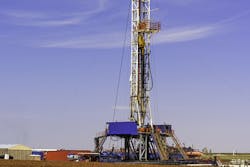Water challenges in Permian Basin fracturing operations
In the boardrooms of every exploration and production (E&P) operator in the Permian Basin, it’s likely that water is the main topic of discussion. Until recently, water did not play a critical role in the economics of developing a well, but today, water’s role in well development poses a challenge for operators. Significant bottlenecks and additional logistical complexities need to be addressed sooner rather than later.
First is the issue of sourcing water for completions operation. The increasing lateral length of wellbores continues to bring added efficiency to production and development, and as a result, the volume of water required for fracturing a well increases significantly. This leaves operators facing substantial challenges and costs in sourcing, transporting and storing the water prior to the frack. Once a well is brought online and production begins, the water challenges continue. For every barrel of oil produced, operators are producing multiple barrels of water. These volumes are higher than initially anticipated, and the region is now working hard to understand immediate and long-term solutions to deal with the produced water volumes.
Sourcing to completion: The role of water in Permian Basin well development
It’s no secret that the demand for hydraulic fracturing in the Permian Basin is on the rise. What is less commonly understood is how the high completion activity is affecting water demand in the area. For example, a fracturing job in the Permian today typically requires between 300,00 barrels (bbls) and 1 million bbls of water. The requirement for so much water results from extended lateral lengths in order to gain additional access, stimulate as much of the reservoir as possible, and drive more efficiency in production. As field production continues, more operators will trend to larger pads with multiple wells, which results in more water sourcing, transfer, storage and maintenance at each pad location.
Some operators have freshwater wells available to them for their fracturing operations. Others purchase water from land owners or additional sources. Oftentimes, contracts are written with a set price for the freshwater source, but the operators also need to be concerned with the transferring of the water to the frack as well as the storage of water near the frack location. In the hot summer months of West Texas, bacteria can grow rapidly in the pits if they are not monitored closely, so timing of storage is also a factor. Management of the pits or storage can be another associated cost in preparing for the frack. Operators are concerned with the environmental impacts of sourcing the large volumes of water now required for operations. E&P companies continue to seek technology and cost-effective solutions to assist in resolving the water challenges facing the industry.
The Permian Basin’s unexpected high rates of produced water
Across the board, the oil and gas industry is seeing an unprecedented amount of water being produced once wells are in production, but this is even more true in the Permian Basin. While water-to-oil ratios for some wells in the Colorado Rockies can range from as low as 3-to-1, they are reported to be as high as 15-to-1 in some areas of West Texas. Part of what makes the Permian an attractive basin for production is cost-efficient drilling, which includes stacked reservoirs. High water cut in the Permian is also a result of the stacked reservoirs; multiple layers can contribute to significant water production. For this reason, frack design, specifically frack height, is an area of focus and optimization for completion engineers.
“Water-to-oil ratios … are reported to be as high as 15-to-1 in some areas of West Texas. Part of what makes the Permian an attractive basin for production is cost-efficient drilling, which includes stacked reservoirs.”
Traditionally, produced water is disposed of in saltwater disposal (SWD) wells; however, high water volumes are making disposal increasingly costly from an economic and environmental perspective. Some areas, most notably in Oklahoma, have seen seismicity issues related to water disposal dependent on the geology and faults in the region. The West Texas region has also experienced increased seismicity with increased activity levels, and it is currently being monitored.
Environmental concerns are just one of the looming potential constraints of current disposal practices. Additionally, trucks loaded with water are arriving at disposal sites only to sit in line at backlogged facilities. Trucking also results in higher traffic, increased potential for vehicle accidents in the respective communities where operations are underway, and elevated emissions. At the same time, permits to drill and operate new disposal wells are taking significantly longer to process. This, combined with new potential regulations, makes many speculate that disposal wells will reach capacity and supplementary solutions will be needed — and fast.
Near-term solutions for Permian Basin fracturing can bridge cost-effectiveness with improved sustainability
Challenges in water sourcing and disposal have led to a growing number of water engineers joining the industry. Water management teams are becoming responsible for both immediate and long-term solutions that are cost-effective and environmentally responsible. Water management teams are influencing the industry as they work with new technology partners to test and implement solutions. Among the first of these solutions is treating water for nearby reuse. By planning to reuse produced water nearby, there are savings on trucking and piping, but it must be initially determined how the water will be treated and to what level.
Generally, there is a continued debate on what the best key performance indicators (KPIs) should be for water quality, but all agree that water must be at least treated for bacteria before it is reused. One option is oxidizing disinfection technology, such as Gradiant Energy Services’ (GES) Free Radical Disinfection — a safe, environmentally friendly bacteria treatment solution. It uses an electrolytic cell to generate a mixed oxidant solution, including multiple free radicals injected into the water stream. Operationally, it is manned by one individual who works alongside the frack crew, treating at up to 120 barrels per minute (bpm). The oxidation reduction potential (ORP) level of the water is increased, thus eliminating bacteria while using the technology at a lower cost than traditional chemical biocides.
The next level of treatment encompasses recycling to a clean brine. Historically, options for recycling to a clean brine struggled with consistency due to changing influent water qualities. One solution is GES’s SCE technology in which the chemical precipitation process is controlled through an algorithm that GES engineers utilize with a chemical plan to reduce chemical consumption and cost. Unlike traditional systems, the patented clarifier then easily removes solids from the system. Challenging parameters such as iron are treated with the system to levels as low as 0.5 parts per million (ppm).
Across the region, operators need to treat at various water quality levels, and operators look for options at treatment and pricing levels to reuse produced water and flowback water for future fracturing operations.
Long-term solutions move from availability to adoption
Today, more advanced technologies exist and emerge for the mass treatment and disposal of water. With increased volumes putting increased pressure on operators, the Permian expects to see more testing and adoption of solutions that once seemed distant for the oil and gas industry.
The first of these is desalination. GES’s desalination process, Carrier Gas Extraction, uses a patented technology of a bubble column to replicate the humidification/dehumidification that occurs in a natural rain cycle. Throughout the process, water is purified to a level close to that of drinking water. By treating water to such a high quality, the system is helping forward-thinking operators recycle for fracturing operations, and in the future, the treated water may be used for applications such as agriculture. The byproduct is a heavy brine that can also be reused in drilling and completions operations.
U.S.-based operators also consider evaporation solutions. GES’s Carrier Gas Concentrator achieves evaporation through a multistage bubble column humidification system at high rates of heat and mass transfer. The technology requires less energy than traditional evaporation because it does not heat the water directly yet utilizes a heat exchanger. As a result, the system has less scaling and maintenance issues as well as a reduction in emissions from traditional methods. It is also a mobile solution, creating a unit that can treat water at the most critical sites until water production is minimized.
“A higher influx of water engineers are joining the industry and creating shifts in the way operators think about water management and invest in technologies.”
Conclusion
As trucks filled with Permian water sit idle in traffic or in backlogged saltwater disposal (SWD) facilities, the economic pressure to find better immediate solutions is underway. Already, a higher influx of water engineers are joining the industry and creating shifts in the way operators think about water management and invest in technologies. As disposal wells inevitably reach capacity, regulations come into play, and produced water continues to increase, the industry will need to address these challenges. The increased demand for sustainable solutions will accelerate adoption in unconventional areas such as the Permian, and the oil and gas industry will see winners when it comes to water management. Advanced water technology that provides consistent performance as well as mobile solutions will be a platform for operators to continue to focus on in the highly regulated and complex environment of the industry.
Julie Villalobos is vice president of sales and marketing at Gradiant Energy Services (GES). With more than 15 years in oil field services, she has experience servicing small and large E&P customers. Prior to GES, Villalobos was a former field engineer at Schlumberger. She received a Bachelor of Science in environmental and civil engineering from Ohio State University.

